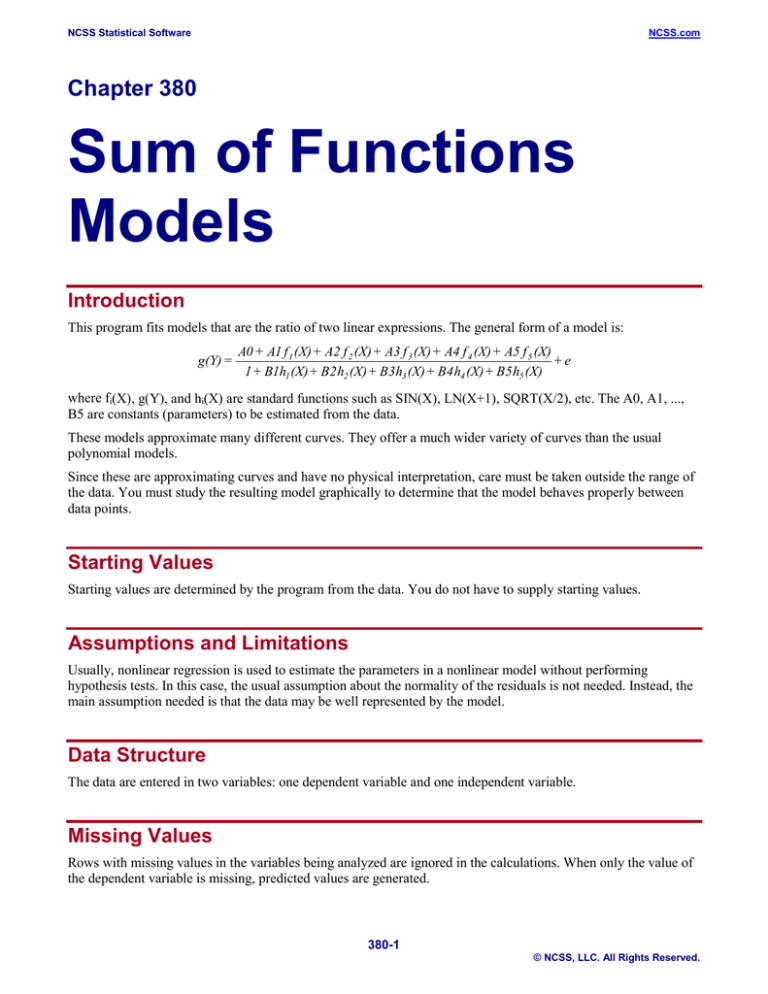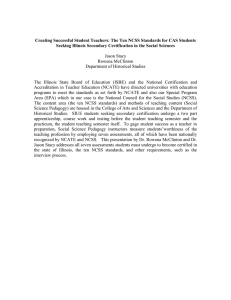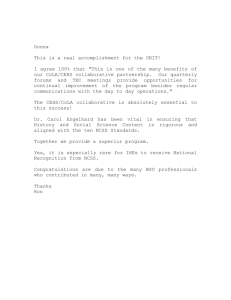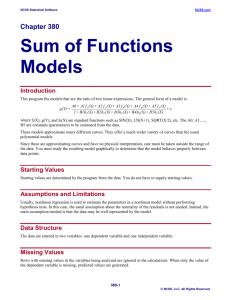
NCSS Statistical Software
NCSS.com
Chapter 380
Sum of Functions
Models
Introduction
This program fits models that are the ratio of two linear expressions. The general form of a model is:
g(Y) =
A0 + A1 f 1 (X)+ A2 f 2 (X)+ A3 f 3 (X)+ A4 f 4 (X)+ A5 f 5 (X)
+e
1+ B1h1 (X)+ B2 h2 (X)+ B3h3 (X)+ B4 h4 (X)+ B5 h5 (X)
where fi(X), g(Y), and hi(X) are standard functions such as SIN(X), LN(X+1), SQRT(X/2), etc. The A0, A1, ...,
B5 are constants (parameters) to be estimated from the data.
These models approximate many different curves. They offer a much wider variety of curves than the usual
polynomial models.
Since these are approximating curves and have no physical interpretation, care must be taken outside the range of
the data. You must study the resulting model graphically to determine that the model behaves properly between
data points.
Starting Values
Starting values are determined by the program from the data. You do not have to supply starting values.
Assumptions and Limitations
Usually, nonlinear regression is used to estimate the parameters in a nonlinear model without performing
hypothesis tests. In this case, the usual assumption about the normality of the residuals is not needed. Instead, the
main assumption needed is that the data may be well represented by the model.
Data Structure
The data are entered in two variables: one dependent variable and one independent variable.
Missing Values
Rows with missing values in the variables being analyzed are ignored in the calculations. When only the value of
the dependent variable is missing, predicted values are generated.
380-1
© NCSS, LLC. All Rights Reserved.
NCSS Statistical Software
NCSS.com
Sum of Functions Models
Procedure Options
This section describes the options available in this procedure.
Variables Tab
This panel specifies the variables used in the analysis.
Variables
Y (Dependent) Variable
Specifies a single dependent (Y) variable.
Y Transformation
Specifies a power transformation of the dependent variable. Available transformations are
Y’=1/(Y*Y), Y’=1/Y, Y’=1/SQRT(Y), Y’=LN(Y), Y’=SQRT(Y), Y’=Y (none), and Y’=Y*Y
X (Independent) Variable
Specifies a single independent (X) variable.
Model
Bias Correction
This option controls whether a bias-correction factor is applied when the dependent variable has been
transformed. Check it to correct the predicted values for the transformation bias. Uncheck it to leave the predicted
values unchanged. See the Introduction to Curve Fitting chapter for a discussion of the amount of bias and the
bias correction procedures used.
Model – Numerator and Denominator Terms
These options specify up to five terms for use as the numerator and/or denominator of the model. You do not have
to have a denominator.
Function
Select one of the eighteen possible transformations for this term.
f(z)=1/(z^2)
f(z)=LN(z)
f(z)=z^2=z*z
f(z)=z^5
f(z)=SIN(z)
f(z)=SINH(z)
f(z)=1/z
f(z)=SQRT(z)
f(z)=z^3
f(z)=EXP(z)
f(z)=COS(z)
f(z)=COSH(z)
f(z)=1/SQRT(z)
f(z)=z (none)
f(z)=z^4
f(z)=EXP(-z)
f(z)=TAN(z)
f(z)=TANH(z)
where
z = MX+A; M and A are constants that are supplied in the two options below.
Add (A)
X may be scaled using the equation z=MX+A. This option sets the value of A. If you want to ignore this option,
set A=0.
380-2
© NCSS, LLC. All Rights Reserved.
NCSS Statistical Software
NCSS.com
Sum of Functions Models
Multiply (M)
X may be scaled using the equation z=MX+A. This option sets the value of M. If you want to ignore this option,
set M=1.
Options Tab
The following options control the nonlinear regression algorithm.
Options
Lambda
This is the starting value of the lambda parameter as defined in Marquardt’s procedure. We recommend that you
do not change this value unless you are very familiar with both your model and the Marquardt nonlinear
regression procedure. Changing this value will influence the speed at which the algorithm converges.
Nash Phi
Nash supplies a factor he calls phi for modifying lambda. When the residual sum of squares is large, increasing
this value may speed convergence.
Lambda Inc
This is a factor used for increasing lambda when necessary. It influences the rate at which the algorithm
converges.
Lambda Dec
This is a factor used for decreasing lambda when necessary. It also influences the rate at which the algorithm
converges.
Max Iterations
This sets the maximum number of iterations before the program aborts. If the starting values you have supplied
are not appropriate or the model does not fit the data, the algorithm may diverge. Setting this value to an
appropriate number (say 50) causes the algorithm to abort after this many iterations.
Zero
This is the value used as zero by the nonlinear algorithm. Because of rounding error, values lower than this value
are reset to zero. If unexpected results are obtained, you might try using a smaller value, such as 1E-16. Note that
1E-5 is an abbreviation for the number 0.00001.
Reports Tab
The following options control which reports and plots are displayed.
Select Reports
Iteration Report ... Residual Report
These options specify which reports are displayed.
380-3
© NCSS, LLC. All Rights Reserved.
NCSS Statistical Software
NCSS.com
Sum of Functions Models
Report Options
Alpha Level
The value of alpha for the asymptotic confidence limits of the parameter estimates and predicted values. Usually,
this number will range from 0.1 to 0.001. A common choice for alpha is 0.05, but this value is a legacy from the
age before computers when only printed tables were available. You should determine a value appropriate for your
needs.
Precision
Specify the precision of numbers in the report. Single precision will display seven-place accuracy, while the
double precision will display thirteen-place accuracy. Note that all reports are formatted for single precision only.
Variable Names
Specify whether to use variable names or (the longer) variable labels in report headings.
Plots Tab
This section controls the plot(s) showing the data with the fitted function line overlain on top and the residual
plots.
Select Plots
Function Plot with Actual Y ... Probability Plot with Transformed Y
These options specify which plots are displayed. Click the plot format button to change the plot settings.
Storage Tab
The predicted values and residuals may be stored on the current database for further analysis. This group of
options lets you designate which statistics (if any) should be stored and which variables should receive these
statistics. The selected statistics are automatically stored to the current dataset while the program is executing.
Note that existing data is replaced. Be careful that you do not specify variables that contain important data.
Storage Columns
Store Predicted Values, Residuals, Lower Prediction Limit, and Upper Prediction Limit
The predicted (Yhat) values, residuals (Y-Yhat), lower 100(1-alpha) prediction limits, and upper 100(1-alpha)
prediction limits may be stored in the columns specified here.
380-4
© NCSS, LLC. All Rights Reserved.
NCSS Statistical Software
NCSS.com
Sum of Functions Models
Example 1 – Fitting a Sum of Functions Model
This section presents an example of how to fit a sum of functions model. In this example, we will fit the model
Y=A0+A1/(X+0.5)+SIN(X/2)+A3TANH(X)
to the variables Y and X of the FnReg1 database.
You may follow along here by making the appropriate entries or load the completed template Example 1 by
clicking on Open Example Template from the File menu of the Sum of Functions Models window.
1
Open the FnReg1 dataset.
•
From the File menu of the NCSS Data window, select Open Example Data.
•
Click on the file FnReg1.NCSS.
•
Click Open.
2
Open the Sum of Functions Models window.
•
Using the Analysis menu or the Procedure Navigator, find and select the Sum of Functions Models
procedure.
•
On the menus, select File, then New Template. This will fill the procedure with the default template.
3
Specify the variables.
•
On the Sum of Functions Models window, select the Variables tab.
•
Double-click in the Y Variable box. This will bring up the variable selection window.
•
Select Y from the list of variables and then click Ok.
•
Double-click in the X Variable box. This will bring up the variable selection window.
•
Select X from the list of variables and then click Ok.
•
Under the Numerator Terms heading, select 1/z in the first Function box.
•
Under the Numerator Terms heading, enter 0.5 in the first Add (A) box.
•
Under the Numerator Terms heading, select SIN(z) in the second Function box.
•
Under the Numerator Terms heading, enter 0.5 in the second Mult (M) box.
•
Under the Numerator Terms heading, select TANH(z) in the third Function box.
4
Specify the reports.
•
On the Sum of Functions Models window, select the Reports tab.
•
Check the Residual Report box. Leave all other reports and plots checked.
5
Run the procedure.
•
From the Run menu, select Run Procedure. Alternatively, just click the green Run button.
Minimization Phase Section
Minimization Phase Section
Itn
Error Sum
No. Lambda
Lambda
0
5.915745 0.00004
Convergence criterion met.
A0
2.070158
A1
4.885924
A2
1.059697
A3
7.084624
This report displays the error (residual) sum of squares, lambda, and parameter estimates for each iteration. It
allows you to observe the algorithm’s progress. Since no denominator terms were selected, the model was solved
on the first iteration using standard multiple linear regression.
380-5
© NCSS, LLC. All Rights Reserved.
NCSS Statistical Software
NCSS.com
Sum of Functions Models
Model Estimation Section
Model Estimation Section
Parameter
Name
A0
A1
A2
A3
Parameter
Estimate
2.070158
4.885924
1.059697
7.084624
Asymptotic
Standard Error
1.075332
0.5628729
6.202012E-02
0.9798195
Lower
95% C.L.
-6.435943E-02
3.768631
0.9365882
5.139698
Upper
95% C.L.
4.204676
6.003218
1.182806
9.029551
Dependent
Y
Independent
X
Model
Y=(A0+A1*(1/(X+.5))+A2*(SIN((.5*X)))+A3*(TANH(X))) / (1)
R-Squared
0.956784
Iterations
0
Estimated Model
(2.070158+(4.885924)*1/(X+.5)+(1.059697)*SIN((.5*X))+(7.084624)*TANH(X))
Parameter Name
The name of the parameter whose results are shown on this line.
Parameter Estimate
The estimated value of this parameter.
Asymptotic Standard Error
An estimate of the standard error of the parameter based on asymptotic (large sample) results.
Lower 95% C.L.
The lower value of a 95% confidence limit for this parameter. This is a large sample (at least 25 observations for
each parameter) confidence limit.
Upper 95% C.L.
The upper value of a 95% confidence limit for this parameter. This is a large sample (at least 25 observations for
each parameter) confidence limit.
Model
The model that was estimated. Use this to double check that the model estimated was what you wanted. Note that
the “/(1)” at the end emphasizes that there was no denominator specified.
R-Squared
There is no direct R-Squared defined for nonlinear regression. This is a pseudo R-Squared constructed to
approximate the usual R-Squared value used in multiple regression. We use the following generalization of the
usual R-Squared formula:
R-Squared = (ModelSS - MeanSS)/(TotalSS-MeanSS)
where MeanSS is the sum of squares due to the mean, ModelSS is the sum of squares due to the model, and
TotalSS is the total (uncorrected) sum of squares of Y (the dependent variable).
This version of R-Squared tells you how well the model performs after removing the influence of the mean of Y.
Since many nonlinear models do not explicitly include a parameter for the mean of Y, this R-Squared may be
negative (in which case we set it to zero) or difficult to interpret. However, if you think of it as a direct extension
of the R-Squared that you use in multiple regression, it will serve well for comparative purposes.
Iterations
The number of iterations that were completed before the nonlinear algorithm terminated. If the number of
iterations is equal to the Maximum Iterations that you set, the algorithm did not converge, but was aborted.
380-6
© NCSS, LLC. All Rights Reserved.
NCSS Statistical Software
NCSS.com
Sum of Functions Models
Estimated Model
The model that was estimated with the parameters replaced with their estimated values. This expression may be
copied and pasted as a variable transformation in the spreadsheet. This will allow you to predict for additional
values of X.
Analysis of Variance Table
Analysis of Variance Table
Source
Mean
Model
Model (Adjusted)
Error
Total (Adjusted)
Total
DF
1
4
3
96
99
100
Sum of
Squares
10559.48
10690.45
130.9726
5.915745
136.8883
10696.37
Mean
Square
10559.48
2672.613
43.65752
6.162234E-02
Source
The labels of the various sources of variation.
DF
The degrees of freedom.
Sum of Squares
The sum of squares associated with this term. Note that these sums of squares are based on Y, the dependent
variable. Individual terms are defined as follows:
Mean
The sum of squares associated with the mean of Y. This may or may not be a part of
the model. It is presented since it is the amount used to adjust the other sums of
squares.
Model
The sum of squares associated with the model.
Model (Adjusted)
The model sum of squares minus the mean sum of squares.
Error
The sum of the squared residuals. This is often called the sum of squares error or just
“SSE.”
Total
The sum of the squared Y values.
Total (Adjusted)
The sum of the squared Y values minus the mean sum of squares.
Mean Square
The sum of squares divided by the degrees of freedom. The Mean Square for Error is an estimate of the
underlying variation in the data.
Asymptotic Correlation Matrix of Parameters
Asymptotic Correlation Matrix of Parameters
A0
A1
A2
A0
1.000000
-0.972405
0.786167
A1
-0.972405
1.000000
-0.831952
A2
0.786167
-0.831952
1.000000
A3
-0.999209
0.964719
-0.779440
A3
-0.999209
0.964719
-0.779440
1.000000
This report displays the asymptotic correlations of the parameter estimates. When these correlations are high
(absolute value greater than 0.95), the precision of the parameter estimates is suspect.
380-7
© NCSS, LLC. All Rights Reserved.
NCSS Statistical Software
NCSS.com
Sum of Functions Models
Predicted Values and Residuals Section
Predicted Values and Residuals Section
Row
No.
1
2
3
4
.
.
.
X
0.5
0.5959596
0.6919192
0.7878788
.
.
.
Y
10.16989
10.83415
10.93412
10.71519
.
.
.
Predicted
Value
10.49218
10.62378
10.77391
10.92673
.
.
.
Lower 95.0%
Value
9.92255
10.07584
10.24289
10.40745
.
.
.
Upper 95.0%
Value
11.06181
11.17172
11.30493
11.44602
.
.
.
Residual
-0.3222909
0.2103729
0.1602088
-0.2115456
.
.
.
The section shows the values of the residuals and predicted values. If you have observations in which the
independent variable is given, but the dependent (Y) variable was left blank, a predicted value and prediction
limits will be generated and displayed in this report.
Residual Plots
380-8
© NCSS, LLC. All Rights Reserved.
NCSS Statistical Software
NCSS.com
Sum of Functions Models
Function Plot
This plot displays the data along with the estimated function and prediction limits. It is useful in deciding if the fit
is adequate and the prediction limits are appropriate.
In poorly fit models, we have found that it is often necessary to disable the prediction limits so that the data will
show up. In these cases, the prediction limits may be so wide that the scale of the plot does not allow the data
values to be separated.
Residual versus X Plot
This is a scatter plot of the residuals versus the independent variable, X. The preferred pattern is a rectangular
shape or point cloud. Any nonrandom pattern may require a redefining of the model.
Normal Probability Plot
If the residuals are normally distributed, the data points of the normal probability plot will fall along a straight
line. Major deviations from this ideal picture reflect departures from normality. Stragglers at either end of the
normal probability plot indicate outliers, curvature at both ends of the plot indicates long or short distributional
tails, convex or concave curvature indicates a lack
of symmetry, and gaps or plateaus or segmentation in the normal probability plot may require a closer
examination of the data or model. We do not recommend that you use this diagnostic with small sample sizes.
Predicting for New Values
You can use your model to predict Y for new values of X. Here’s how. Add new rows to the bottom of your
database containing the values of the independent variable that you want to create predictions for. Leave the
dependent variable blank. When the program analyzes your data, it will skip these rows during the estimation
phase, but it will generate predicted values for all rows, regardless of whether the Y variable is missing or not.
380-9
© NCSS, LLC. All Rights Reserved.




